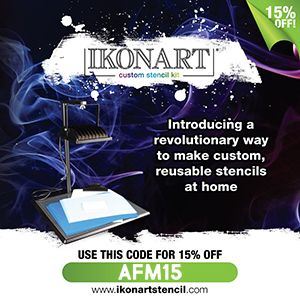Learn how to create a pair of shimmery polymer clay Mermaid Earrings to be a part of your world!

I've been having so much fun creating jewelry and trying new techniques with polymer clay lately. These Polymer Clay Mermaid Earrings are such a fun accessory for summertime, and they turned out better than I ever imagined. Not only are they mermaid shaped, but I added a mermaid scale pattern using my secret weapon - custom silkscreen stencils using my Ikonart kit! I've been so excited to share this project with you, and I hope you get inspired to give it a try.

To make your own Polymer Clay Mermaid Earrings, you will need these supplies:
- Polymer Clay - pink, blue, purple, white
- Mermaid Scale Pattern (for personal use only)
- Ikonart Custom Stencil Kit
- Squeegee
- Baking Mat or Ceramic Tile
- Clay Roller or Clay Rolling Machine
- Acrylic Paint
- Mermaid Clay Cutter Set
- Iridescent Glitter (optional)
- Gloss Glaze or UV Resin
- 10mm Jump Rings
- 2 Jewelry Eye Screws
- 2 Earring Hooks
- Jewelry Pliers
*Save 15% on Ikonart supplies when you shop with code AFM15
Printables, designs, and cut files from Artsy-Fartsy Mama are for personal use only. You may use these files for personal projects, but you may not sell them. If you'd like to share this project digitally, share a link to this post/website only. Do not share a direct link to the file.

To make a stencil, you need to start with a printed design. Download the Mermaid Scale Pattern design (for personal use only) and make sure to print the design* as dark as possible on either inkjet or laser Ikonart Printer Film.
Set up the Ikonart exposure stand by following the directions included in the kit. Ikonart Stencil Film is light sensitive, so be careful to keep it out of sunlight and bright lights before exposure! Cut the film to the same size or slightly larger than the design print.
Lay the piece of film down on the base of the stand with the textured side facing UP. Place the printed design on top of the stencil film, making sure it's right-side up. This means that if there are words in your design, you should be able to read them.
Lastly, place the clear exposure sheet (found in the stencil film pack) on top and press it down well to seal the design tight against the stencil film. Turn the exposure light on and expose the film for 30-35 seconds.
*I often place smaller designs, like this one, on printouts with other designs. Then I can create multiple stencils at once!

The final step in the stencil-making process is to washout, or rinse, the stencil. Clip the exposed stencil film to the Ikonart clipboard with the shiny side (carrier sheet) touching the clipboard. Use the kitchen sink sprayer to rinse the stencil film with warm water until the design shows through and becomes completely clear. The washout process shouldn't take more than 3 minutes.
Gently blot excess water off the the stencil, and hang or lay flat to dry for about 45 minutes. When the stencil is dry, you shouldn't see any water spots or discoloration. Once completely dried, place the it back on the exposure stand and expose it again for at least 2 minutes without the clear cover sheet on top. This extra exposure time will increase the durability of the stencil so you can get as much use out of it as possible.
Use a permanent marker and write "back" on the carrier sheet (shiny side) on the back of the stencil. This helps later when you put the carrier sheet and the stencil back together when you are done using it.


For the next step, you can continue using the clay roller or you can use a clay rolling machine. Fold the strip of clay in half, lining up the same colors. Flatten the folded clay by rolling or running it through the machine. Fold in half again, and flatten. Repeat this process until you see the edges of each color of clay blend together (see image above). The more you repeat the process, the more blended the edges will become.

Use a clay roller with rings (or line 2 craft sticks parallel to each other with the clay in between) to evenly flatten the clay to a 3mm thickness.
Remove the carrier sheet from the back of the stencil and place it over the clay. Rub it down gently with your fingers or use the roller to make sure the stencil is pressed down well and that there aren't any air bubbles trapped underneath.
Tip: If you work directly on a baking mat or ceramic tile, you don't have to worry about transferring your project when it's time to bake the clay. This also helps reduce the chances of you accidentally ruining your project in the process.

Add a small line of acrylic paint at the edge of the stencil. Use a squeegee to gently pull the paint across to the opposite edge. Don't press hard, just skim over the top of the stencil. Scrape the excess paint away and put it back into the paint bottle.

Slowly lift the stencil up to reveal the painted pattern underneath. If you see anywhere that you may have missed while peeling the stencil away, carefully lay the stencil back down and add a little more paint over the area.
If everything looks good as you get to the end of the stencil, remove the stencil completely. Let the paint dry before moving on to the next step (don't worry - it doesn't take long). Wash the stencil well following the instructions below.
Washing Stencils:
For best results, wash stencils while the paint is still wet. To wash your stencil so that it can be used again and again, first get the clipboard wet so your stencil doesn't stick to it. Place the stencil on the clipboard with the textured side up, and lightly rub the stencil under cold running water to remove all the paint.
Do not rub or scrub the adhesive side of the stencil, and NEVER use anything other than water to wash the stencils. To prevent the stencil from breaking down, don't ever leave the stencils to soak.
Remove the stencil from the clipboard and lay it down with the adhesive side up. While the stencil is still wet, place the carrier sheet onto the stencil so that the word “BACK” is readable. Hang or lay the stencil flat to dry completely.

Cut two tails (per earring) using the mermaid tail cutter. Place the cutter over the clay and gently press it straight down, and then gently pull the cutter straight up. If the clay stays down, leave it there. If it comes up with the cutter, be careful how you remove it. Poking through the top to push the clay out can leave dents or misshape the earring piece.
Here's a few tricks & tips for cutting clay that have worked for me:
- Place a piece of plastic wrap over the clay first, and then cut the clay.
- Dip the cutter in corn starch or talcum powder before cutting
- Your clay or workspace might be too warm. Put the clay in the fridge or freezer to cool it down before cutting.

Use a toothpick or a small circle cutter to make holes at the top end of the earring pieces to be able to easily connect them later.

Because I believe mermaids should be *extra* magical, I decided to coat the surface of the mermaid tails with iridescent glitter! Simply dip a soft brush or a fingertip into the glitter, and gently brush it onto the surface of the clay. The clay is tacky enough to immediately hold the glitter on the surface!

Next, make the shell bras for the mermaid earrings! Cut them out of white polymer clay using the mermaid shell cutter, using the same tips used for the tail pieces. If you want to add extra sparkle to the shells, you can dust the surface with glitter.
The center of the shell bras is quite small to cut a hole in to attach to the tail piece. To fix this, I took a small piece of extra clay used for the tails, and rolled it into a small ball. Place the clay ball over the center of the shell bra, and then use a toothpick or a small circle cutter to create a hole through both layers.
You also need to create a vertical hole down the center of the shell top so that you can connect it to the earring hook. I added a small piece of white clay to the center at the top, but hid it so you can't see it from the front. Then, you can use a toothpick to create a hole or you can twist a small jewelry eye screw into the clay.

Use a fine sandpaper to clean up the edges of the earring pieces. To give the earrings a shiny and professional-looking finish, you can apply a coat of gloss glaze or UV Resin to the surface with a toothpick. This extra finish will also keep the glitter in place so it doesn't flake off!



Use pliers to open a 10-12mm jump ring for each earring. Hook the rings through the hole in the top of the tail piece and then through the hole in the shell bra to connect them together. Close the jump ring with the pliers. Next, gently open the bottom of the earring hook and attach it through the eye screw. Close the ring, and the earrings are complete!
I can't say enough how much I love this pair of mermaid earrings, and I could NOT have applied that mermaid scale pattern without the help of my Ikonart kit. These earrings are such a fun summer accessory, and an even better gift idea! If you try making some of these Polymer Clay Mermaid Earrings, I would love to see them! Leave me a comment, or tag a photo on Facebook, Twitter, or Instagram! #AFMcrafts
Don't forget to Pin, Like, and Share!











